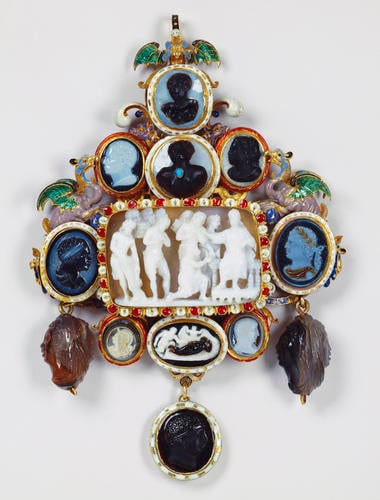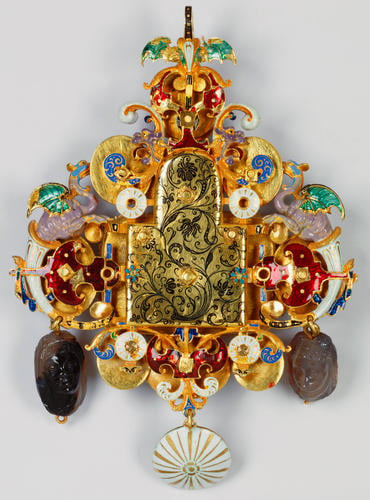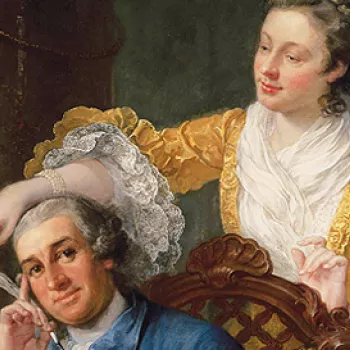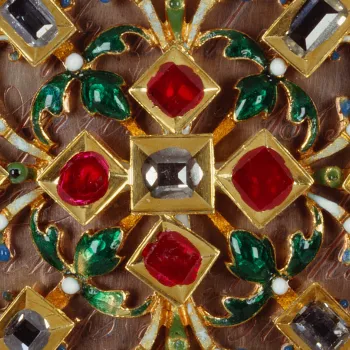Pendant with thirteen cameos early 17th c. cameos with mounts added in the 18th c.
Gold, émail en ronde bosse, émail champlevé, sardonyx, turquoise, black and white onyx, sard, brown and grey agate, black and grey agate, niccolo | 13.0 x 8.9 cm (whole object) | RCIN 65256
-
Gold openwork pendant with opaque white and middle-blue enamel foliate scrolls and two dragons on cornucopiae in opaque mauve, translucent green and opaque pale-blue émail en ronde bosse on either side of a central arched niche. The jewel is surmounted by a winged dragon in polychrome émail en ronde bosse with a black and white enamelled suspension loop.
Obverse: a central rectangular brown and white sardonyx cameo depicting Joseph and his brethren, surrounded by a frame of alternating opaque white and translucent red ‘petals’. Nine cameos in white and gold or translucent red enamel frames are arranged around the central stone: to the left, a bust of an African man, in sardonyx, in profile to the right; to the right, a laureate bust of a Roman emperor, in sardonyx, in profile to the left; above are three brown and white sardonyx cameos of African men and the head of an emperor in black and white onyx, in profile to the left; below, to the left, a head of Minerva in brown and grey agate, in profile to the left; in the centre, a nymph on a couch accompanied by satyrs in sardonyx; to the right, the head of an emperor in white and grey onyx in profile to the right. Suspended from the bottom of the jewel are three pendant cameos: in the centre the head of an emperor in sard, in profile to the right, surrounded by a gold and opaque white enamel frame; to the left and right two double-sided African heads, in black and grey agate.
Reverse: floral design in black champlevé; enamel on the gold backing of the central niche. Eight of the cameos have had their original rivet attachments replaced by screws and nuts. The original dark-red cement behind the central cameo has subsequently been removed.
Some of the cameos are possibly contemporary with the original pendant but the ‘assemblage’ is of a much later date. The original pendant jewel had a central scene, perhaps in enamelled gold; its tabernacle shape suggests the possibility of a religious theme. In its previous state the jewel was probably studded with gemstones attached by tiny screws, for which there are clearly holes prepared in the scrollwork background. The three cameo pendants probably replaced pearls. The mount of the large central cameo in particular recalls the style of Jean Vangrol, the Flemish jeweller and valet de chambre to Marie de’ Medici, who worked in Paris until his death in 1640
The large central cameo represents Joseph enthroned to the right. He faces his brothers, who are seeking mercy following the theft of the silver chalice. Juda kneels before his brother and the others bow their heads. The disembodied brothers are the result of spreading out the original oval composition into a rectangular format. The foreground figures are fairly close to the prototype but the treatment is entirely different. The pose of Joseph has become completely frontal, stiff and hieratic. All the figures are deeply undercut and moulded in the round. The central brother appears more like a 16th century representation of Christ in a Baptism scene and the kneeling figure of Juda recalls the adoring King in traditional Magi representations. Research has suggested a possible attribution of this cameo to Francesco Tortorino, a Milanese gem-engraver who was trained in the circle of Giovanni Bernardi and was known to have specialised in classicising subjects.
The sardonyx cameo representing a Roman emperor to the right of the centre is probably ancient. The remaining cameos and the pendant heads all appear to be 16th century.
The method of attaching the cameos to the original jewel is crude: new holes have been bored into the framework to secure several of the pieces. It would seem that a Renaissance jewel, reduced to fragmentary state, was employed as a convenient background on which to display this heterogeneous collection of gems.
This transformation appears to have occurred in the early 18th century, certainly before 1737 for the jewel, complete with cameos, was in the collection of Queen Caroline, consort of George II. The connection with Queen Caroline opens up fascinating possibilities as to the origin of the ‘assemblage’. It may have been a gift from the Queen’s great friend Elisabeth Charlotte of the Palatinate (1652-1722), known as Liselotte. Liselotte was an enthusiastic collector of gems, particularly after the death of her husband, the Duke of Orléans, in 1701. Liselotte was in constant correspondence with Queen Caroline from 1715 to 1722 and from these letters it is known that they exchanged gifts. In one letter Liselotte writes of her search for French items which might please Caroline and other letters mention presents of ‘engraved stones’. Liselotte was certainly a link with the French interest in gem collecting started by Louis XIV and continued by members of the French royal family.
If this hypothesis is accepted, the terminus ante quem for the ‘assemblage’ must be put back, perhaps to around 1720. This would certainly give the jewel a special place in the history of cameo-displaying objets d’art. It was not long before this that Johann Melchior Dinglinger began producing fabulous objets d’art for Augustus the Strong, Elector of Saxony, (whose brother and predecessor had married Caroline’s mother in 1692) from his vast collection of gems and cameos.
The Pendant was probably the ‘large cameo set round with several others’ included among the ‘Curiosities sent to his Majesty [George III] from Kensington’ by Horace Walpole on 22 March 1764. It was listed at Windsor Castle in an inventory at Windsor Castle in 1830 and was among the cameos at Windsor ‘taken away by command of Her Majesty [Queen Victoria] to arrange in suitable cases’ on 26 October 1838.
Text adapted from Ancient and Modern Gems and Jewels in the Collection of Her Majesty The Queen, London, 2008Provenance
The jewel is identifiable with the ‘hanging Jewell of onexes containing 12 heads and a piece of figures in the middle’ included in ‘The Inventory of the Curiositys & Medals in the cabinet of His Majesty’s Library’ at Kensington Palace, compiled before 1755. All the pieces included in that inventory almost certainly came from Queen Caroline’s collection. Also probably the 'large cameo set round with several others' included among Queen Caroline's 'Curiosities sent to his Majesty from Kensington' by Horace Walpole on 22 March 1764. Subsequently, listed at Windsor Castle in 1830 and among the cameos at Windsor 'taken away by command of Her Majesty to arrange in suitable cases' on 26 October 1838 (WCIJ 1830, f.38; QVIJ 1838, f.13).
-
Creator(s)
(nationality)Acquirer(s)
-
Medium and techniques
Gold, émail en ronde bosse, émail champlevé, sardonyx, turquoise, black and white onyx, sard, brown and grey agate, black and grey agate, niccolo
Measurements
13.0 x 8.9 cm (whole object)
87 mm (Width) x 25 mm (Depth); 127 mm (Length); 178 g (Weight) (whole object)
Category
Subject(s)
Place of Production
France











